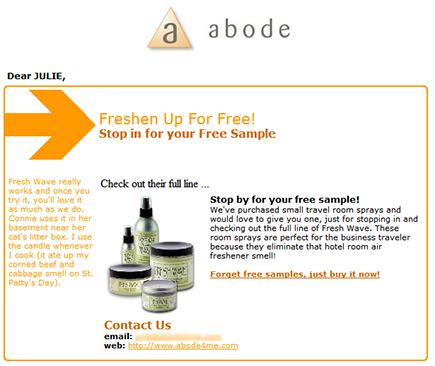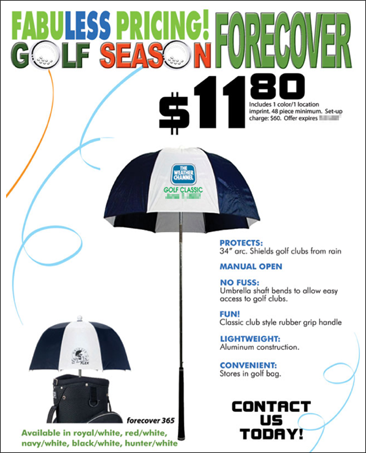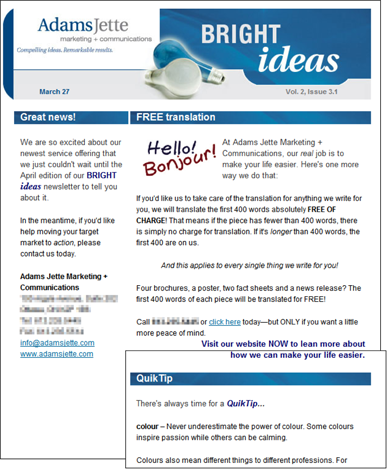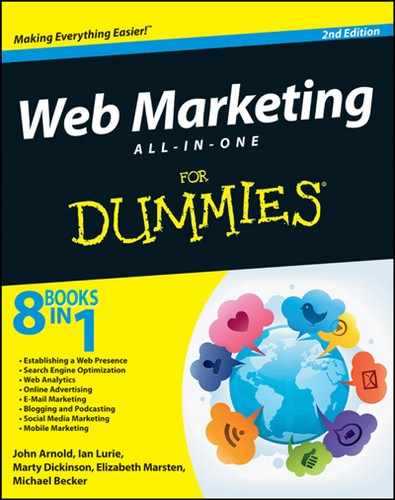Chapter 5: Making Your E-Mail Content Valuable
In This Chapter
![]() Determining the value of your e-mail content
Determining the value of your e-mail content
![]() Including valuable offers in your e-mails
Including valuable offers in your e-mails
![]() Coming up with a strong call to action
Coming up with a strong call to action
![]() Making your e-mails inherently valuable
Making your e-mails inherently valuable
![]() Giving your e-mails relevance over time
Giving your e-mails relevance over time
When people subscribe to your e-mail list, they share personal information with the expectation of receiving something valuable. Consumers aren’t likely to value multiple e-mails that highlight only the distinguishing characteristics of your business. Repetitive e-mail content results in subscriber boredom. And boring your audience leads to low open rates, lost clicks, and unsubscribe requests.
Keeping your e-mail content valuable over time helps ensure that your list subscribers keep their attention and their subscription active while you attempt to capture purchases from them throughout the course of each buying cycle. The two basic types of value when it comes to e-mail content are
• An offer that is valuable when acted upon
• An inherent value, that is, content that’s valuable in and of itself
Valuable content won’t automatically make your audience rush to your business to part with their money. Your e-mail also needs to have a strong call to action to give your content a purpose and prompt your audience to help you meet your objectives.
This chapter covers some fundamental guidelines for including value in your e-mail strategy to deliver important information about your business while giving your audience continued reasons to open, read, and take action on your e-mails, no matter which stage of the buying cycle they’re in.
Sending Valuable Offers
Offers are conditional statements that give your audience one or more reasons to make an immediate decision instead of postponing a decision.
Because the value in postponing a decision almost always has to do with the fact that people prefer to hold on to their money, offers usually take the form of discounts and savings. However, some people value other types of offers. The following sections describe money-saving offers as well as other types of offers.
Creating content to promote something
When the main idea of your e-mail is to promote your products or services, your e-mails need to include descriptions and images that support your promotion. Here are some ideas and sources for creating promotional content to include in your e-mails:
• Ask manufacturers for content. Companies that manufacture your products are great sources for product descriptions, images, and headlines.
• Take digital photos. Use a digital camera to create product photos and show your services in action.
• Ask your customers for descriptions. Sometimes your customers can describe your products or services in ways that speak to your audience better than you can.
• Ask people to write testimonials. Asking people to tell you about their experiences can be interesting and relevant to your audience as well as be powerful motivators. Testimonials don’t have to come from your customers. Sometimes you can find examples of other people who have used products and services like yours and demonstrate how their testimonial applies to your business.
 Make sure that you have permission to use testimonials.
Make sure that you have permission to use testimonials.
• Check your e-mail. Keeping track of the types of e-mails your customers and prospects send to you can give you insight into the topics that interest your audience. When your customers and prospects ask questions and make inquiries about your business, use your answers to help you develop content that promotes how your products or services help solve their problems. For example, a business consultant who gets several e-mails asking about the impact of mobile marketing is wise to create an e-mail addressing the most common questions or concerns related to mobile marketing and the services provided by the consultant.
Cashing in on coupons
Coupons are traditionally printed on paper and redeemed in person, but e-mail coupons can take many forms, such as
• Printable HTML designs on a web page or in an e-mail for use in a brick-and-mortar store
• Codes that customers enter into a form field when making an online purchase
• Links that include special HTML code that applies a change to the price field of a product database when someone clicks to view the product or add it to an online shopping cart
Most E-Mail Marketing Providers (EMPs) allow you to create dotted-line borders to give your coupon content the appearance of being clippable. If you format your coupons to have a traditional cut-out look on-screen, make sure that your coupons include redemption directions because consumers need to know how to redeem your coupon. (After all, they can’t just cut it out of the computer screen.) For example, if you intend for your consumers to print the coupon, cut it out, and come to your store for redemption, include those instructions in your e-mail. Figure 5-1 shows an e-mail that includes traditional-looking coupons as well as directions for using the coupons.
Figure 5-1: Include redemption directions with coupons.

Courtesy of Fajita Grill
Including incentives
Incentives are limited-time offers that reward a specific action. Incentives differ from coupons in that no physical redemption process is involved to take advantage of an incentive. Incentives are highly flexible; they can take the form of financial savings or special privileges. For example, a low financing rate might be the initial incentive to purchase a particular car, but membership to an exclusive automobile club is an additional incentive for purchasing the same car.
Incentives are particularly useful when you can identify your audience’s specific interests and then match your audience’s interests with your incentive. For example, if you know that your audience likes baseball, you might include two free tickets to a baseball game as an incentive for making an immediate purchase.
Using giveaways
Giveaways are complimentary products or services that are awarded to a single winner or a limited number of participants who take a specific action. Giveaways allow you to offer your audience a chance at winning a valuable prize or special privileges without having to worry about meeting the demand for a high number of requests for freebies. In addition to rewarding purchases, using giveaways can motivate your audience to
• Share more of their interests and contact information
• Respond to surveys and polls
• Forward your e-mails to friends and colleagues
Figure 5-2 shows an e-mail that offers a giveaway to reward a visit to the store.
Figure 5-2: This e-mail offers a giveaway to a limited number of people who visit the store.

Courtesy of Abode
Making gains with loss leaders
A loss leader is an offer to purchase a product or service that results in a financial loss to your business to gain a new customer who represents more profitable revenue in the future. For example, a camera store might be willing to sell a specific type of camera for far less than all its competitors to obtain highly profitable printing and accessory sales from those customers.
Loss leaders are useful when some of the people on your e-mail list have to experience the quality of your products or services firsthand before they can understand the true value that’s inherent in your regular prices. Because loss leaders represent a customer acquisition cost, reserve them for obtaining customers who have never purchased from you before.
Extending urgent offers
Sometimes, products or services are valuable enough to cause an immediate purchase decision all by themselves because they fulfill a need that your audience perceives as an emergency. For example, a landscaping company might offer to blow out sprinkler systems for their audience because a cold front is moving in that has the potential to freeze pipes and cause serious water damage.
Writing an Effective Call to Action
Even when your content is valuable, most consumers simply scan and delete your e-mails unless you prompt them with alternatives. If decreasing your deletion rate is one of your objectives, every e-mail you send needs to include a strong call to action. A call to action is a statement that prompts your audience to complete one or more specific tasks in favor of your objectives.
Anyone who reads e-mail is familiar with the stalwart phrase Click Here, but such generic phrases are not necessarily models for writing an effective call to action. An effective call to action acts like a little sign that allows your audience to visualize the steps involved to take advantage of your e-mail’s content. Figure 5-3 shows an e-mail offer that includes the call to action Contact Us Today!.
Figure 5-3: This e-mail includes an offer and a call to action.

Courtesy of Impressions Marketing
Words are the building blocks of a strong call to action, and the quality and the number of words that you choose significantly affect how many responses your call to action receives. The most effective way to write a call to action is to begin with one or more action words: verbs that propose a specific task to your audience.
The following list offers calls to action, paired with strong verbs that you could choose to help motivate a reader to act:
• Read your e-mail: Read, look, consider, notice, scroll
• Fill out a form: Contact, respond, comment, advise
• Save your e-mail: Save, keep, store, file, move
• Request information: Download, request, learn, e-mail, compare
• Print your e-mail: Print, post, bring, hang
• Visit a physical location: Drive, come, park, attend
• Forward your e-mail: Forward, share, send, refer
• Visit a web page: Visit, view, go, navigate
• Make a purchase: Buy, add, purchase, own, order
• Register for an event: Register, reserve, sign up, R.S.V.P.
• Phone your business: Call, phone, dial
• Make an appointment: Schedule, arrange, meet, set up
Here’s how you can build on action words to create a strong call to action. You can see the progression of the call to action as you make it stronger and stronger:
1. Combine your action word with the subject of the action word.
Order this item.
2. Include the place where the action happens.
Order this item online.
3. Add the urgency of the action.
Order this item online before Friday.
4. Finish with an adjective to underscore the value that’s inherent in the action.
Order this hilarious item online before Friday.
Giving Your E-Mail Content Inherent Value
E-mails containing valuable information based on your knowledge and experience are generally more effective over long periods of time than e-mails that repeatedly contain only offers. Even when your offers are compelling, people aren’t always ready to take action right away.
The longer your sales cycle and average time between repeat purchases, the more you need to include inherently valuable content in your e-mails to keep your audience subscribed and interested. Figure 5-4 shows an e-mail that contains an offer with a “quick tip” section included as inherently valuable content to enhance the overall value of the e-mail.
Figure 5-4: This e-mail uses a QuikTip section for inherently valuable content.

Courtesy of Adams Jette Marketing & Communications
The following sections detail how you can create inherently valuable content or combine it with various related offers.
Creating content to inform your audience
When the main objective of your e-mail is to deliver information, you might find yourself looking for facts, data, and expert opinions to help you make your case and add an element of authority to your information. Here are some ideas and sources for creating informative content to include in your e-mails:
• Be an aggregator. Sometimes the best way to tell your story is to let someone else tell it. Information abounds on the Internet, and the chances that your audience is going to find exactly what you want them to read are relatively low. Aggregating information from the Internet is a great way to generate content and inform your audience with the information you want them to see.
 Make sure that you have permission to include excerpts of other people’s online information in your e-mails before you include them. Also, ask whether you can post the content on your website with a link to the outside source so that people who click links in your e-mail are sent to your website before they have the opportunity to link to someone else’s website.
Make sure that you have permission to include excerpts of other people’s online information in your e-mails before you include them. Also, ask whether you can post the content on your website with a link to the outside source so that people who click links in your e-mail are sent to your website before they have the opportunity to link to someone else’s website.
• Have an opinion. If you don’t have time to search for outside content and ask for permission to aggregate information, you can save yourself and your audience a lot of time by summarizing outside information for your audience. For example, a fashion designer who reads a lot of fashion magazines could create an e-mail that summarizes the two most stylish ways to tie a scarf so that the audience doesn’t have to read all the scarf-tying articles in all the fashion magazines.
• Be an expert interviewer. If you find yourself running out of opinions, you can usually find someone with expert information and advice for your audience. Instead of borrowing content, ask someone whether you can interview him about his expertise and share it with your audience. Interviews can also be broken up into themes or individual questions and included in a series of e-mails.
• Find a storyteller. People love to tell stories, and some of them can help you to inform your audience. Start by asking your current customers to tell you stories about their experiences with your business and your products or services.
Adding tips and advice
If your products or services require special knowledge for customers to use them, or if your audience needs a trusted opinion to buy your products in the first place, including tips and advice in your e-mails can reinforce your expertise.
Here are some ideas for including tips and advice in your e-mails:
• Start a tips and advice e-mail newsletter where the bulk of your content is informative. For example, a gardening center might send an e-mail newsletter with tips for keeping gardens alive with less effort, or advice on plants that thrive with little or no attention. The gardening newsletter could include related offers for plants mentioned in the newsletter, or separate offers could be sent after the audience has enough information to engage in the buying cycle.
• Include one tip in each promotional e-mail you send with a link to additional tips on your website. For example, a shoe store could include the location of a secret hiking trail in every e-mail with a link to an archive of hiking trails featured in the past. If you include single tips in your e-mails, make sure that your website’s Tips page includes related offers.
• Share your opinion. If you and your audience have the same beliefs, sharing your opinion can strengthen your customer relationships. For example, a store that sells recycled products might have a customer base that’s more likely to be concerned about the environment. Such a customer base might be more loyal to a company that includes opinions concerning recycling issues along with offers to purchase recycled products.
• Share another opinion. If your audience doesn’t perceive you as an expert in your field, find an expert who is willing to share an opinion. You can ask permission to include opinions in your e-mails or interview an opinionated expert and include the highlights of the interview in your e-mail.
• Dedicate a section of your e-mail newsletter to answering customer questions. For example, a website designer could answer a different customer question related to search engine optimization in every e-mail.
Providing instructions and directions
If your products or services require your customers to follow detailed instructions, include information that gives your audience timesaving shortcuts. For example, an e-mail promotion from an online auction might include steps for setting up account options. Here are some ways that you can include instructions and directions in your e-mails:
• Ask your customers to submit creative shortcuts. You can then feature the shortcuts in your e-mails.
• If your directions involve several detailed steps, include one step with details in each e-mail. For example, a hobby store could include instructions for building a great model airplane, beginning with choosing a model and ending with painting and displaying the model.
• Include instructions that are valuable for reference, and ask your audience to save them in their e-mail inboxes. For example, a promotion for a product that includes a one-year warranty could include return and refund instructions along with instructions for saving the information in case a problem occurs with a recent or future purchase.
Putting in entertaining content
Some audiences value e-mail content that gives them a good laugh or diverts their attention with an interesting story. If your products or services are related to entertaining content and your audience values diversion, the following examples of entertaining content might be appropriate:
• Retell the stories you hear from your customers that relate to using your products and services. For example, a business that sells boats might include interesting stories about customers who live on the ocean or use boats to help people in the community.
 If you include such stories, make sure that you have permission from your customers before you send those stories to your list.
If you include such stories, make sure that you have permission from your customers before you send those stories to your list.
• Include links to online videos that are related to your products or services. For example, a guitar store might include a link to a video showing a different guitar hero who plays the guitars that the store sells.
 As with any link to content you don’t own, make sure that you have permission to include the link, and also make sure that the content you’re linking to is legally obtained.
As with any link to content you don’t own, make sure that you have permission to include the link, and also make sure that the content you’re linking to is legally obtained.
• Write your own stories about your experiences or knowledge relating to your products or services. For example, the owner of a restaurant might include stories about her trips to the French vineyards that inspire the wines featured in the restaurant.
Including facts and research
If you sell products or services that are enhanced by helpful facts and research, you can include them in your e-mails to add value to related offers. Here are a few possibilities:
• Conduct your own research and publish your findings in your e-mails. For example, a men’s clothing store could conduct a poll and find out how many women think it’s fashionable for men to wear pink shirts. The results of the poll could be included along with a pink shirt sale if the results support wearing pink shirts — or blue shirts if the results indicate that pink is out of favor.
• Include facts and research through external sources. Facts and research abound on the Internet, and the people who publish them are usually willing to share their findings with proper attribution to the source. If you locate facts and research that interest your audience, ask the source whether you can include them in your e-mails.
Finding Help with Content Creation
You can turn to many sources for help in creating interesting and relevant content for your e-mails. Marketing companies and content providers can help you when
• You don’t have time to create e-mail content.
• Your content isn’t giving you the results you want.
• You don’t like creating your own content for your e-mails.
Marketing companies and content providers often have services that range from small amounts of copywriting to fully outsourced, turnkey solutions. Most companies that provide content creation for e-mail marketing provide one or more of the following services:
• Copywriting, using themes and ideas that you provide
• Formatting content that you provide into HTML for e-mail
• Custom e-mail template design
• Advice and consulting
• Image creation, design, and licensing
• Matching your website content to your e-mails
• Archiving e-mail campaigns to your website
For a list of marketing companies and content providers that can help you with e-mail content design and creation, ask for a list of business partners, education partners, or professional services at www.constantcontact.com.

 You should also think through the financial implications that your coupon might create if someone tries to abuse your offer. Including an expiration date and limiting the number of redemptions per product or customer can help to limit any attempts to maliciously exploit your coupon’s basic intentions.
You should also think through the financial implications that your coupon might create if someone tries to abuse your offer. Including an expiration date and limiting the number of redemptions per product or customer can help to limit any attempts to maliciously exploit your coupon’s basic intentions.